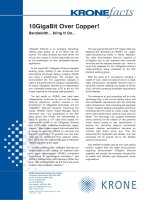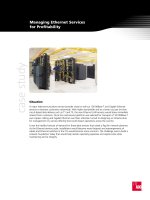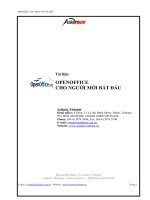Tài liệu Red hat -Why Open Source Software pptx
Bạn đang xem bản rút gọn của tài liệu. Xem và tải ngay bản đầy đủ của tài liệu tại đây (239.68 KB, 14 trang )
Expert Reference Series
www.globalknowledge.com
1-800-COURSES
Written and Provided by
Why Open Source Software Can Help Create a More Secure IT Infrastructure
Evaluating the state of IT security and associated market statistics, it is apparent that
traditional operating environments have not consistently provided acceptable levels of
security to enterprise computing. Security-related exposures, liabilities, and losses are
rapidly increasing, while conventional computing (hardware, system software, and network
bandwidth) costs are all decreasing strongly year over year. Most of the operating
environment vendors do not embrace a holistic approach to security - it is clearly an
afterthought. There are major systemic flaws in their approach to security - and users are
suffering the consequences every day.
"I'm not proud We really haven't done everything we could to protect our customers-Our
products just aren't engineered for security"
Brian Valentine, senior vice president, Windows Development, Microsoft
1
1
Berger, Matt. "Lead Windows Developer Bugged by Security". InfoWorld. September 5, 2002.
Copyright ©2002 Red Hat, Inc.
Table of Contents
Introduction 3
The Proprietary Software Position 4
The Open Source Position 6
Performance Analysis: Separating the Wheat from the Chaff 9
But Does Open Source Really Work in the Real World? 11
Summary 13
Why Open Source Software Can Help Create a More Secure IT Infrastructure 2
Introduction
The open source security position challenges the failing status quo. Increasing
security issues underline the fact that the proprietary "hide-the-code" approach is not
working.
Red Hat asserts that open source operating systems are
inherently more secure than proprietary alternatives.
The objective of this white paper is to present the requirement for ubiquitous,
affordable security. It forwards the open source security position and presents
empirical evidence, comparative methodology analysis, and references user
experiences to support this position.
The whitepaper reviews the contrasts between proprietary and open source software
in the following areas:
Universal Commodity Security
Hidden/Open Code
Vendor/User Alignment
Vendor Responsibility
Security Management
Performance Analysis
Real-world User Experience
Why Open Source Software Can Help Create a More Secure IT Infrastructure 3
In 1843, Oliver Wendell Holmes
startled U.S. physicians by
publishing a paper asserting that a
disease killing as many as one in five
mothers, and in some hospitals
every new mother over a period of
months was not only contagious, but
borne to its victims by the very
doctors who sought to cure it.
According to the Harvard Gazette,
"Holmes' denunciation of the medical
profession as a carrier of a plague
rather than a deliverer from disease
marked a milestone in both Holmes'
medical career and in the prevention
of the illness." Could it be that
computer and information security is
being compromised in a similar
fashion by the very software
companies who are promising to
make their systems "trustworthy"
Could it be that the software industry
is today as wrong about effective
security procedures as doctors were
about causes of infections in the
mid-19
th
century?
The Proprietary Software Position
Universal Commodity Security: No Organization is an Island
In today's pervasive Internet-connected computing environment, security must be
ubiquitously available and affordable to provide true universal assurance. Proprietary
operating system practices for establishing secure and resilient enterprise systems are built
on multi-level, multi-product approaches. This approach is cost prohibitive - and the cost
trajectory of security technologies ensures the widening of the gap between the "haves"
and "have nots".
Considering the pragmatic position, beyond availability, security must be an organizational
priority in development and operations/management. Any organization's failure to remain
current compromises not only its own security, but that of its collaboration and trading
network. The total cost of ownership for proprietary security management is significant due
to the requirement for constant attention. This too is a significant obstacle to ubiquitous,
commodity security.
In addition to cost obstacles to universal commodity security, organizations often reject
proprietary security investments based on the fact that they are ineffective and inflexible.
As a consequence of expense and functional shortcomings, organizations are inclined to
under invest. In summary, proprietary approaches limit the path to universal commodity
security.
II. Hidden / Open Code: The "Dark" Security Science
The number-one issue with the security of proprietary operating system software is that
users are denied access to the source code. Proprietary vendors apply the logic that
hidden is secure. The sensational IT security newspaper headlines of the last five years
have underlined the fact that this "dark science" is not effective.
An organization would never move into a facility without an understanding of the placement
of the doors and windows. If an organization rented a physical facility and was not
informed of a hidden building vulnerability of which the facility provider was aware, and its
business was compromised by that vulnerability, this would clearly provide grounds for a
lawsuit. This practice of hiding known vulnerabilities is the norm for proprietary providers of
operating systems that fulfill mission-critical software infrastructure functions. The reality is
that it is impossible for organizations to proactively assess vulnerabilities and develop
appropriate responses with proprietary operating systems.
Considering highly sensitive security environments, in cryptography circles the maxim is
that the security of an algorithm should not depend on its secrecy. For example, the
Clipper chip, RIAA digital watermarks, and ebooks all used cryptography developed in
Why Open Source Software Can Help Create a More Secure IT Infrastructure 4
secrecy, through code that was never audited. In each circumstance, the code was
successfully cracked. Closed, or proprietary software can be reverse engineered and
protocols can be (and have repeatedly been
2
) cracked through analysis. Secrecy or
obscurity is not an effective security approach.
III. The Vendor/User Alignment: The Conflict - What is "Need to Know"?
There is a fundamental user/vendor conflict that exists in the proprietary operating system
security "need-to-know" position. Proprietary vendors frequently hide behind the "user
interest and exposing customers to great vulnerability" argument to withhold information on
vulnerabilities that are known to the operating system developer. Customers that rely on
sole source providers are subject to the vendor's priorities, timelines, and business
plans/objectives.
IV. Vendor Responsibility
It is apparent that a huge number of organizations run their businesses on proprietary
operating systems. The developers of these systems have often failed to assume
responsibility in assuring the security of their products. In addition to pushing out flawed
products without adequate code review to understand the vulnerabilities that they are
handing on to customers, these vendors frequently fail to publicize system vulnerabilities -
either at the time of discovery or thereafter. As a result patch penetration is low - systems
with known vulnerabilities go unpatched for months, even years. For example, the CERT®
CC reports that 60,000 hosts are still compromised by Code Red and are actively scanning
14 months after patches were first made available.
V. Security Management: When the Cure is Worse than the Disease
The proprietary vendor approach to significant infrastructure vulnerabilities is the new
upgrade. Organizations are asked to install and pay for "fork lift" updates that frequently
drive broader changes in their operating environments. As such, organizations are
sometimes reluctant to update their systems as the impact may prove disruptive on the
broader scale.
2
Clipper chip, Four forms of digital watermarking, etc.
Why Open Source Software Can Help Create a More Secure IT Infrastructure 5
The Open Source Position
The fundamental nature of open source development provides a higher degree of
responsiveness and faster resolution to security vulnerabilities than proprietary operating
system vendors can provide. The combination of open code accessibility and the leverage
associated with the large number of developers using and testing the software provide
critical differentiators. Collaboration, peer review, and rapid feedback are enabled in global
real time through the open source development model. Considered together, these factors
accelerate resolution times for critical security vulnerabilities.
I. Universal Commodity Security
The open source community asserts that for operating system security to become truly
ubiquitous, it must also be highly accessible through commodity hardware and software.
As the TCP/IP protocol, World Wide Web, Apache web server, and Linux operating system
have shown, when good technology has a low acquisition cost, it displaces inferior
solutions that cost more. When the acquisition costs are low and all interfaces and
implementations are published, such technologies can become standards. Standards, in
turn, drive both direct and indirect adoption (the network effect). The growth of the Internet,
World Wide Web, Apache, and Linux provide dramatic testimony to the power of the
network effect and the popularity of the open source distribution model.
The big-picture goal is universal commodity security - enhancing security across all nodes
and users, thereby creating a less hostile security context for each machine or user. Open
source security is uniquely positioned to lead and sustain a new network effect that the
industry so much needs today.
II. Hidden/Open Code: Open Disclosure and Superior Development Methodology
Open source software, by definition, includes any program or application in which the
programming code is open and visible. Open source users recognize significant security
benefits that flow from the accessibility of the source code. The open source development
model is underpinned by the assurance that source code for an open source project will be
made generally available.
Why Open Source Software Can Help Create a More Secure IT Infrastructure 6
Open source projects are typically developed on the basis of meritocracy and have a
central person or body that approves developed code for "official" releases, making them
widely available to the larger open source development community. This basic
development methodology is markedly distinct from proprietary software development.
Code access provides the ability to analyze and review the source code. In the case of
Linux over 125,000 users and developers from around the world have participated in the
process. When users team with vendors to become part of the solution, then "black hat"
crackers are at a disadvantage. Code access dramatically improves the software
development process, which is not possibly achievable by proprietary software vendors.
The code accessibility that defines and reinforces the open source development model
supports the creation of standards, a more responsive development process, and faster
vulnerability disclosures.
III. Vendor / User Alignment: Eliminating the Vendor/User Conflict
Open source pressures developers and vendors to fully disclose vulnerabilities and
accurately reveal their impact, allowing customers to analyze the vulnerability and look at
the effect that it would have on their systems and the consequences of applying a fix.
Open source software is generally provided and supported by a number of competing
vendors. Fixing security issues occurs without the impact of business and financial drivers.
This forces vendors to accelerate the timetable for fixes and promotes the elimination of
vulnerabilities even in the absence of known threats.
IV. Vendor Responsibility
The fact that there are so many vulnerabilities posted in many different places makes
staying current on security a complex and time consuming undertaking. The open source
community asserts that operating system security is the inherent responsibility of vendors.
The industry needs to take a proactive stance in assisting users. As Red Hat provides a
single source for a number of open source programs, it takes a responsible position by
providing a single source for security notifications and updates.
Software vendors need to be accountable for software assurance, innovative in their
approaches to software design to enable and respond to security, and support industry
standards for reporting and addressing vulnerabilities. Ultimately, security must be able to
pay for itself, not only in averting worst-case scenarios, but also in dealing with the many
issues of real-world day-to-day operations.
3
3
In 1982, Philip Crosby published the book "Quality Is Free". His perspective and industry examples showed that in fact quality could pay for itself when it
was an enabler of the process, not merely a hoped-for by-product.
Why Open Source Software Can Help Create a More Secure IT Infrastructure 7
V. Security Management: Overcoming Complexity and Overhead - Assuring
Relevance
Open source minimizes security management complexities and overhead through
preciseness of software changes and back porting of fixes. Back porting ensures that
security updates contain only the security fixes and not any additional features or bug fixes
that could affect system stability.
Open source vendors provide mechanisms to quickly and easily apply security patches to
users' environments through automated alert and update services like Red Hat Network,
Ximian Red Carpet and Caldera Volution. Red Hat Network tracks user software
installations for over 600,000 subscribers. As Red Hat tracks security vulnerabilities, it
applies a relevance filter, and alerts users only of issues relevant to their environment. Red
Hat Network empowers organizations to automatically update their IT systems - even
without user interaction if preferred.
Why Open Source Software Can Help Create a More Secure IT Infrastructure 8
Performance Analysis: Separating the Wheat
from the Chaff
No operating system is immune to security vulnerabilities. According to BUGTRAQ
Vulnerability Database Statistics (www.kbeta.com/securitytips/vulnerabilities/), both open
source and proprietary operating systems have varying numbers of reported vulnerabilities
year to year. The increasing complexity of software development, coupled with the growing
deployment of system software within consumer as well as business and public sector
markets, has resulted in greater volumes of vulnerabilities reported each year.
Numbers of vulnerabilities in a given operating system can correlate to many factors,
including:
Number of installed images
Code accessibility
Number of features or embedded applications within an OS
As such, it is more useful to evaluate vendor responsiveness to security vulnerabilities,
rather than comparing net numbers of vulnerabilities for a given operating system.
Security Portal Study: Bug/Security Fix Response Times
Security Portal conducted an independent analysis in 2000 to determine comparative open
source vs. proprietary operating system bug/security fix response times. The results:
Red Hat had the best score, with 348 recess days on 31 advisories, for an average of
11.23 days from bug to patch
Microsoft had 982 recess days on 61 advisories, averaging 16.10 days from bug to patch
Sun proved itself to be very slow, although having only 8 advisories; it accumulated 716
recess days, a whopping three months to fix each bug on average”.
(source: Security Portal, 2000. />Why Open Source Software Can Help Create a More Secure IT Infrastructure 9
Open Source Users - Not Afraid of Worms
All the worms that have affected Red Hat Linux so far have been written to take advantage
of known defects. The table below shows the effectiveness of the open source approach to
vulnerability audit. Community developers became aware of the following vulnerabilities
(see table below) and issued patches before hackers had the opportunity to write worms to
exploit those issues. It is important to note that any system that had been kept up-to-date
would not have been affected by any of the Linux worms. For each worm introduced,
administrators had a minimum of forty-five days to four months to apply patches. The fact
that the worms were able to affect any users at all, shows that it is important for systems to
be kept up to date.
Linux Worms
Name Date Worm Found
Red Hat
Update
Available
Security
Availability
Window
Slapper Sept 2002 July 2002 45 days
Adore Apr 2001 Jan 2001 64 days
Lion Mar 2001 Jan 2001 59 days
Ramen Noodle Jan 2001 Sept 2000 106 days
Why Open Source Software Can Help Create a More Secure IT Infrastructure 10
But Does Open Source Really Work in the Real
World?
The findings of an extensive study published by an Avaya Labs Research, Bell
Laboratories/Lucent Technologies and eBuilt research team are revealing. Vulnerability
considerations were a significant factor in the review that focused on two case studies of
the open source software development model: Apache and Mozilla.
4
The team concluded
that the open source development model offers comparable and often better processes
than proprietary development. It noted that the quality of Apache's secure design, as well
as, open source review practices were a significant factor in driving its outstanding security
track record - see table below:
Apache Security Record
(1.3.0 to 1.3.27 - 4 years, 4 months)
Type of Issue Severity
Number of
vulnerabilities
Denial of service High 5
Show a directory listing Low 4
Read files on the system High 3
Remote arbitrary code execution High 2
Cross site scripting Medium 2
Local privilege escalation Medium 1
Remote root exploit High 0
Why Open Source Software Can Help Create a More Secure IT Infrastructure 11
User Experience: U.S. Department of Defense, Burlington Coat Factory
"Open source allows us the opportunity to have a proactive and pre-emptive identification of
security holes by friendly analysis. As a result, this early identification and rapid repair of
security vulnerabilities has become a major advantage of open source over proprietary
approaches to software development."
- Rob Walker, Program Manager, Defense Information Systems Agency
"The security of open source software hasn't been an issue. It's excellent," said Prince, at
Burlington's headquarters in Burlington, NJ. "On the operating system side, although there
are loopholes found, the speed with which they're fixed and the commitment to making the
problem known and resolved are excellent. The stability rivals the best of the proprietary
UNIX systems. The whole security model in Linux is better than in Windows."
- Mike Prince. CIO, Burlington Coat Factory Warehouse Corp.
"I am a firm believer in trusting highly deployed open source solutions to be more secure,
and more responsive to problems than proprietary solutions. Prior to my arrival, the
department and the City of Charlottesville was 100 percent Microsoft. Since then, we
began a campaign to increase security, save money an address the needs of management.
We chose to standardize on Red Hat as our core open source distribution."
- John Lewis, Security Systems Engineer, City of Charlottesville, VA
Why Open Source Software Can Help Create a More Secure IT Infrastructure 12
Summary
In all scientific fields, only what can be independently reviewed by the academic community
can be accepted by the community as verified. Yet in the field of computers, our science is
practiced as a "black art". Proprietary vendors hide code, obscure protocols, bury defects,
and vehemently deny issues unless questioned under oath. To advance the state of the
computer and information security industry, and importantly the user experience, we must
both appeal to and submit to science. Our military, our government, our businesses
increasingly depend upon computers to survive. In the world of computer security, "publish
or perish" is no longer merely pat career advice meant primarily for academics - it is an
urgent warning to IT professionals and society about how security software should be
trusted. Open source returns the computer security industry to its scientific roots - thereby
enabling progress of substance towards universal assurance.
The principles of open source are simple, yet powerful. They resonate loudly in the security
arena. The more people who have access to the source code and can employ their
expertise to examine it, the fewer secrets are embedded in the code. As a direct result,
code becomes more secure.
Why Open Source Software Can Help Create a More Secure IT Infrastructure 13









